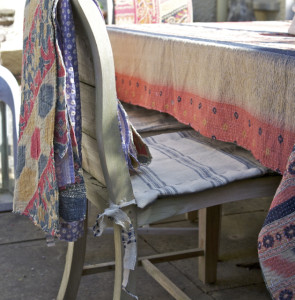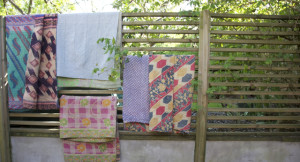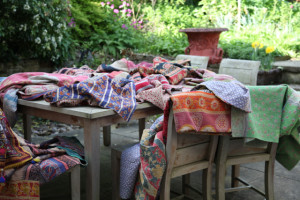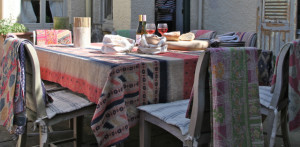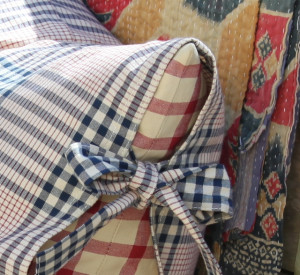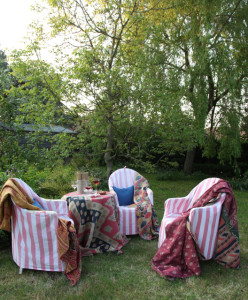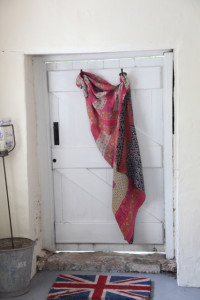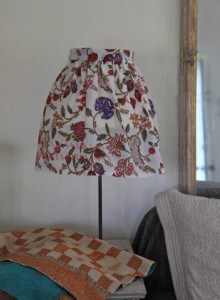I use them constantly and everywhere – in the garden especially, as bomb-proof sofa throws and bedhead covers.
A traditional Indian running stitch that is used for a form of quilting; also the name of fabric worked in this way. Kanthas are made from layers of old materials, usually whole or patchworked pieces of sari that are sandwiched together between new cloth by rows of running stitches worked by hand; this makes them lovely and snuggly without being cumbersome and heavy
Although usually in parallel rows, Kantha stitches can also be worked in circles or swirls. The edges can be beautifully finished or quite rough, depending on the intent or skill of the individual maker.
The ones I’ve bought have been approx.. 145 cm (c.a. 57”) wide and 2.10 cm (c.a. 82.7”) long. We’ve used them for cushions, curtains, bedcovers and hangings, and cut the worn ones to upholster smaller items.
And as blog post:
Here are some of things we’ve done with our kantha cloths – actually not much as it happens, but then that’s just the point !!!
Bengal in the northeast of India has an embroidery tradition that we have all come to recognise. It’s called kantha, which translates as coverlets, or blankets – we’d call them quilts – whereby several layers of cotton are stitched together to create a thicker, padded cloth.
The year-round moist climate of Bengal, especially around modern day Kolkata, (Calcutta ) is perfect for both spinning and weaving, and provides cotton calico for dyeing and printing across India.
Kantha can be made either of cotton or silk, but most commonly from recycled cotton saris. The best fabric lengths are used for the top and bottom, patched where they need to be, enclosing the more worn and torn ones. Sometimes the outer layers are new, but on the whole these are less attractive as the colours haven’t had the same chance to fade by washing and sun bleaching. The beauty of the work is that it takes up little space, requires minimal equipment, and can be managed easily – picked up and put down again at will, perhaps just a few, snatched, minutes at a time.
As domestic embroideries, kantha were originally made only by the women of the house, for use within the house – on beds and as wall hangings. As with all domestic handworks, there are certain ideals, patterns to follow, and pride of workmanship to uphold, so that many of them are intricately worked in the tradition of the area, with floral motifs and running borders, centre patterns and panels of flora, fauna, and the stories of life.
In the most common form though, and these that we see most often right now, kantha are simply stitched with parallel rows of running stitches, the ends and edges left unfinished.
For me, one of the fun things about kantha is the seemingly complete disregard for any sort of ‘pattern matching’ or even ‘colour matching’ when it comes to joining. It’s this joyful abandon – almost bohemian – approach that creates the life of the piece. Something that we, in our over-matched environments can take on board.
The whole resonance of kantha- the way the colours are used and the ideal of it, is very much closer to the farmhouse kitchen and country house ideal that so many strive for and miss – becoming lost in the theory of the thing. Because it’s about a feeling, not a formula.
The idea of kantha is, of course, seen all over the world. It’s born of necessity. And of the need – or ethos – to re-use. Waste is a new phenomenon, and were textiles more resilient I’ve no doubt we’d find stitched layers from the beginning of time- or least from the invention of the sewing needle.
In the Western world we have our own padded quilts – Welsh, Northumberland, Provencal boutis, to name a few, and then their American counterparts, and we know these well – if not from real life, then from magazine articles, or books or museum collections. But unlike these, the local Bengalese kantha, as domestic items, were rarely considered worthy of attention by either museums or private collectors, so we have little record of the designs and work before the early 20C.
Sorting to put one on each chair for evening guests ……..
The V & A Museum have a small one from this period on display in the current Fabric of India exhibition ( no. 76 ). It’s just 55.6 x 57.2 cm ( c.a. 22 x 23” ) and from Bangladesh, very finely stitched, depicting people, flora and fauna, with a scrolled leaf border and a centre circular mandala, created with a depth that suggests it was a meditation piece, or temple hanging.
We do know that in the sixteenth and seventeenth centuries intricately worked kantha, or Bengalla quilts, were made for a new European market, commissioned by, and often depicting the coat of arms of, the Portuguese traders who brought them home both for their own use and to sell on, to the cognescenti of Lisbon and London, then throughout Europe.
More recently the ideas and insights of travel, together with the work of charitable organisations working to boost handwork income in rural areas, has created a demand for the simpler kantha works, so they are much more easily found.
Kantha is unique in that it just works with everything ….
European checks…..
Country stripes…
Nothing at all…
And hand blocked prints from it’s own countryside…..

